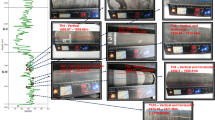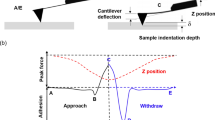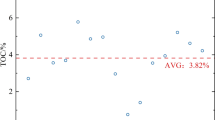Abstract
Understanding the reservoir conditions and material properties that govern the geomechanical behavior of shale formations under in situ conditions is of vital importance for many geomechanical applications. The development of new numerical codes and advanced multi-physical (thermo-hydro-chemo-mechanical) constitutive models has led to an increasing demand for fundamental material property data. Previous studies have shown that deformational rock properties are not single-value, well-defined, linear parameters. This paper reports on an experimental program that explores geomechanical properties of Marcellus Shale through a series of isotropic compression (i.e. σ 1 = σ 2 = σ 3) and triaxial (i.e. σ 1 > σ 2 = σ 3) experiments. Deformational and failure response of these rocks, as well as anisotropy evolution, were studied under different stress and temperature conditions using single- and multi-stage triaxial tests. Laboratory results revealed significant nonlinear and pressure-dependent mechanical response as a consequence of the rock fabric and the occurrence of microcracks in these shales. Moreover, multi-stage triaxial tests proved to be useful tools for obtaining failure envelopes using a single specimen. Furthermore, the anisotropic nature of Marcellus Shale was successfully characterized using a three-parameter coupled model.

























Similar content being viewed by others
Abbreviations
- σ 1 :
-
Major principal stress (axial stress)
- σ 3 :
-
Minor principal stress (confining pressure)
- p :
-
Mean effective stress (i.e. p = (σ 1 + 2σ 3)/3)
- q :
-
Differential stress (i.e. q = σ 1 − σ 3)
- ε a :
-
Axial strain
- ε r :
-
Radial strain
- ε v :
-
Volumetric strain (i.e. ε v = ε a + 2ε r)
- ε s :
-
Distortional strain (i.e. ε s = 2/3(ε a – ε r)
- σ d :
-
Dilation threshold
- σ f :
-
Peak (failure) strength
- σ u :
-
Ultimate strength
- β :
-
Orientation of the failure plane with respect the maximum principal stress
- IC:
-
Isotropic Compression stage (i.e. σ 1 = σ 2 = σ3)
- MSE:
-
Elastic Multi Stage triaxial test
- MSF:
-
Failure Multi Stage triaxial test
- SS:
-
Single Stage triaxial test
- SST:
-
Single Stage triaxial test at high Temperature
- ThC:
-
Thermal Consolidation stage
- TX:
-
Triaxial stage (i.e. σ 1 > σ 2 = σ3)
- VTI:
-
Vertical Transverse Isotropy
References
Bauer A, Holt RM, Stenebråten J, Sønstebø EF, Marøen L (2014) Thermally Induced compaction of shales. In: 48th US rock mechanics/geomechanics symposium, Minneapolis
Bažant Zdenek P, Salviato Marco, Chau Viet T, Visnawathan Hari, Zubelewicz Aleksander (2014) Why fracking works. J Appl Mech 81(10):101010. doi:10.1115/1.4028192
Britt LK, Schoeffler J (2009) The geomechanics of a shale play: what makes a shale prospective! In.: SPE eastern regional meeting, Charleston
Buscarnera G, Cusatis G, Zubelewicz A, Bažant ZP (2014) Shale fracturing for energy recovery: current issues and review of available analytical and computational models. In: Shale energy engineering, pp 168–179. doi:10.1061/9780784413654.018
Davies RJ, Mathias SA, Moss J, Hustoft S, Newport L (2012) Hydraulic fractures: how far can they go? Marine Pet Geol 37(1):1–6. doi:10.1016/j.marpetgeo.2012.04.001
Dewhurst DN, Siggins AF (2006) Impact of fabric, microcracks and stress field on shale anisotropy. Geophys J Int 165(1):135–148. doi:10.1111/j.1365-246X.2006.02834.x
Dewhurst DN, Siggins AF, Sarout J, Raven MD, Nordgård-Bolås HM (2011) Geomechanical and ultrasonic characterization of a Norwegian Sea shale. Geophysics 76(3):WA101–WA111. doi: 10.1190/1.3569599
EIA (2013) U.S. Crude Oil and Natural Gas Proved Reserves
Engelder T (2009) Marcellus 2008: report card on the breakout year for gas production in the Appalachian Basin: Fort Worth Basin. Oil and Gas Magazine, p 18–22
Engelder T, Lash GG, Uzcátegui RS (2009) Joint sets that enhance production from Middle and Upper Devonian gas shales of the Appalachian Basin. AAPG Bull 93(7):857–889. doi:10.1306/03230908032
Eseme E, Urai JL, Krooss BM, Littke R (2007) Review of mechanical properties of oil shales: implications for exploitation and basin modelling. Oil Shale 24(2):159–174
Evans KF, Oertel G, Engelder T (1989) Appalachian stress study, 2. Analysis of Devonian shale core: some implications for the nature of contemporary stress variations and Alleghanian deformation in Devonian rocks. J Geophys Res 94:7155–7170
Ferrari A, Laloui L (2013) Advances in the testing of the hydro-mechanical behaviour of shales. In: Laloui L, Ferrari A (eds) Multiphysical testing of soils and shales. Springer, Berlin, pp 57–68
Fisher K, Warpinski N, Service PAH (2012) Hydraulic-fracture-height growth: real data. SPE Production and Operations
Fjær E, Holt RM, Horsrud P, Raaen AM, Risnes R (2008) Petroleum related rock mechanics, 2nd edn. Elsevier, Amsterdam
Ghassemi A, Suarez-Rivera R (2012) Sustaining fracture area and conductivity of gas shale reservoirs for enhancing long-term production and recovery, College Station
Graham J, Houlsby GT (1983) Anisotropic elasticity of a natural clay. Geotechnique 33:165–180
Hirt AM, Evans KF, Engelder T (1995) Correlation between magnetic anisotropy and fabric for Devonian shales on the Appalachian Plateau. Tectonophysics 247(1–4):121–132. doi:10.1016/0040-1951(94)00176-a
Hoek E, Brown ET (1980) Empirical strength criterion for rock masses. J Geotech Eng Div. doi:10.1016/0148-9062(81)90766-X
Horsrud P (2001) Estimating mechanical properties of shale from empirical correlations
Hu M, Hueckel T (2013) Environmentally enhanced crack propagation in a chemically degrading isotropic shale. Géotechnique 4:313–321
Huotari T, Kukkonen I (2004) Thermal expansion properties of rocks: Literature survey and estimation of thermal expansion coefficient for olkiluoto mica gneiss. Technical report, Geological Survey of Finland
Islam MA, Skalle P (2013) An experimental investigation of shale mechanical properties through drained and undrained test mechanisms. Rock Mech Rock Eng 46(6):1391–1413. doi:10.1007/s00603-013-0377-8
Jacobi D, Gladkikh M, Lecompte B, Hursan G, Mendez F, Longo J, Ong S et al (2008) Integrated petrophysical evaluation of shale gas reservoirs. In: CIPC/SPE gas technology symposium 2008 joint conference. SPE, Calgary
Jaeger JC, Cook NGW, Zimmerman RW (2007) Fundamentals of rock mechanics, 4th edn. Blackwell Publishing, Malden
Josh M, Esteban L, Delle Piane C, Sarout J, Dewhurst DN, Clennell MB (2012) Laboratory characterisation of shale properties. J Pet Sci Eng 88:107–124. doi:10.1016/j.petrol.2012.01.023
Kargbo DM, Wilhelm RG, Campbell DJ (2010) Natural gas plays in the Marcellus Shale: challenges and potential opportunities. Environ Sci Technol 44(15):5679–5684. doi:10.1021/es903811p
King G, Haile L, Shuss J, Dobkins T (2008) Increasing fracture path complexity and controlling downward fracture growth in the Barnett shale. In: SPE shale gas production conference, Fort Worth, pp 1–8. doi:10.2118/119896-MS
Kuila U, Dewhurst DN, Siggins AF, Raven MD (2011) Stress anisotropy and velocity anisotropy in low porosity shale. Tectonophysics 503(1–2):34–44. doi:10.1016/j.tecto.2010.09.023
Lacazette A, Engelder T (1992) Fluid-driven cyclic propagation of a joint in the Ithaca siltstone, Appalachian Basin, New York. In: Evans B, Wong T-F (eds) Fault mechanics and transport properties of rocks. Academic Press, London, pp 297–324
Lings ML, Pennington DS, Nash DFT (2000) Anisotropic stiffness parameters and their measurement in a stiff natural clay. Geotechnique 50(2):165–180
Mavko G, Mukerji T, Dvorkin J (2009) The rock physics handbook. tools for seismic analysis of porous media, 2nd edn. Cambridge University Press, New York
Maxwell S (2011) Microseismic hydraulic fracture imaging: the path toward optimizing shale gas production. Lead Edge 30(3):340–346
Mohamadi M, Gong X, Wan RG (2013) Laboratory and constitutive modeling of Colorado shale at high pressure and temperature. In: American Rock Mechanics Association (ed) 47th US rock mechanics/geomechanics symposium, San Francisco, pp 1–8
Morgan SP, Einstein HH (2014) The effect of bedding plane orientation on crack propagation and coalescence in shale. In: 48th US rock mechanics/geomechanics symposium, Minneapolis
Oertel G, Engelder T, Evans K (1989) A comparison of the strain of crinoid columnals with that of their enclosing silty and Shaly matrix on the Appalachian Plateau, New-York. J Struct Geol 11(8):975–993
Passey QR, Bohacs KM, Esch WL, Klimentidis R, Sinha S, Exxonmobil Upstream (2010) From oil-prone source rock to gas-producing shale reservoir—geologic and petrophysical characterization of unconventional shale-gas reservoirs.” In: CPS/spe international oil & gas conference and exhibition in China 2010. SPE, Beijing, pp 1707–1735
Puzrin AM (2012) Constitutive modelling in geomechanics. Springer, Berlin. doi:10.1007/978-3-642-27395-7
Rickman R, Mullen M, Petre E, Grieser B, Kundert D (2008) A practical use of shale petrophysics for stimulation design optimization: All shale plays are not clones of the Barnett shale. In: SPE annual technical conference and exhibition, Denver
Safari R, Huang J, Mutlu U (2014) 3D analysis and engineering design of pulsed fracturing in shale gas reservoirs. In: 48th US rock mechanics/geomechanics symposium, Minneapolis, pp 1–12
Salager S, François B, Nuth M, Laloui L (2012) Constitutive analysis of the mechanical anisotropy of opalinus clay. Acta Geotech 8(2):137–154. doi:10.1007/s11440-012-0187-2
Sarout J, Guéguen Y (2008a) Anisotropy of elastic wave velocities in deformed shales: part 1—experimental results. Geophysics 73(5):D75–D89. doi:10.1190/1.2952744
Sarout J, Guéguen Y (2008b) Anisotropy of elastic wave velocities in deformed shales: part 2—modeling results. Geophysics 73(5):D91–D103
Savalli L, Engelder T (2005) Mechanisms controlling rupture shape during subcritical growth of joints in layered rocks. Bull Geol Soc Am 117(3–4):436–449. doi:10.1130/B25368
Schmitt L, Forsans T, Santarelli FJ (1994) Shale testing and capillary phenomena. Int J Rock Mech Min Sci Geomech Abstr 31(5):411–427
Sone H (2012) Mechanical properties of shale gas reservoir rocks and its relation to the in-situ stress variation observed in shale gas reservoirs. Standford University, Standford
Sone H, Zoback MD (2013a) Mechanical properties of shale-gas reservoir rocks—part 1: static and dynamic elastic properties and anisotropy. Geophysics 78(5):D381–D392. doi:10.1190/geo2013-0050.1
Sone H, Zoback MD (2013b) Mechanical properties of shale-gas reservoir rocks—part 2: ductile creep, brittle strength, and their relation to the elastic modulus. Geophysics 78(5):D393–D402. doi:10.1190/geo2013-0051.1
Thomsen L (1986) Weak elastic anisotropy. Geophysics 51:1954–1966
Vermylen JP (2011) Geomechanical studies of the Barnett shale, Texas, USA. Standford University, Standford
Villamor Lora R (2015) Geomechanical characterization of Marcellus Shale. University of Vermont, Vermont
Wood DM (2004) Geotechnical modelling. Taylor & Francis, Abingdon. doi:10.4324/9780203477977
Xue Lei, Qin Siqing, Sun Qiang, Wang Yuanyuan, Lee Lee Min, Li Weichao (2014) A study on crack damage stress thresholds of different rock types based on uniaxial compression tests. Rock Mech Rock Eng 47(4):1183–1195. doi:10.1007/s00603-013-0479-3
Yang Sheng-qi (2012) Strength and deformation behavior of red sandstone under multi-stage triaxial compression. Can Geotech J 49(May):694–709. doi:10.1139/T2012-035
Zoback MD (2007) Reservoir geomehanics. Cambridge University Press, Cambridge
Zoback MD, Byerlee JD (1975) The effect of cyclic differential stress on dilatancy in Westerly Granite under uniaxial and triaxial conditions. J Geophys Res 80:1526–1530
Acknowledgments
The authors would like to thank professor Terry Engelder (Geosciences Department, Penn State University) for providing the shale specimens used in this study. We appreciate the help and assistance of professors Nicolas Perdrial and Julia Perdrial (Geology Department, University of Vermont), who helped the authors with the specimen characterization. We also thank professor Mandar Dewoolkar (Civil Engineering Department, University of Vermont) for technical review and useful insights. Finally, the authors would like to acknowledge the National Science Foundation Grant 1429252 for equipment support, as well to thanks Max Graves and Howard for their assistance with X-ray tomography.
Author information
Authors and Affiliations
Corresponding author
Appendix: Vertical Transversely Isotropic Three-Parameter Coupling Model
Appendix: Vertical Transversely Isotropic Three-Parameter Coupling Model
The linear elastic VTI model for a sample with the z-axis being the axis of symmetry can be expressed in terms of five independent parameters, with the compliance matrix as follows:
In the context of triaxial space, Eq. 4 is reduced to:
Note that this compliance matrix is not symmetric since the strain increment and the stress quantities shown in Eq. 5 are not properly work conjugate. Recall that in the context of triaxial space the correctly chosen work-conjugate quantities are p–δε v and q–δε s for the volumetric and the distortional deformations, respectively (δW = σ ij δε ij = pδε v + qδε s). Also, one can only determine E v and ν vh, but not E h or ν hh since they only appear in the composite stiffness “−(1 − ν vh)/E h”.
Equation 5 can be rewritten using the definitions of the triaxial strain increment and stress quantities as shown by Puzrin (2012):
where, K stands for the bulk modulus during isotropic compression (δq = 0); G is the shear modulus for pure shear (δp = 0); and J is the coupling modulus. These three new parameters can be defined in terms of the original five VTI independent parameters (Puzrin 2012) as shown in Eqs. 7–9.
The compliance matrix in Eq. 6 is symmetric (material is elastic and satisfies the law of energy conservation), and the non-zero off-diagonal terms show the ability of the model to reproduce both coupling between volumetric and distortional effects, and the stress path dependency of stiffness (Puzrin 2012). However, this model is only correct in the context of the triaxial test, and only if the symmetry axis stays vertical. If one wants to model the transverse isotropy in a boundary value problem, the five independent parameters of the VTI model have to be used instead.
Rights and permissions
About this article
Cite this article
Villamor Lora, R., Ghazanfari, E. & Asanza Izquierdo, E. Geomechanical Characterization of Marcellus Shale. Rock Mech Rock Eng 49, 3403–3424 (2016). https://doi.org/10.1007/s00603-016-0955-7
Received:
Accepted:
Published:
Issue Date:
DOI: https://doi.org/10.1007/s00603-016-0955-7




